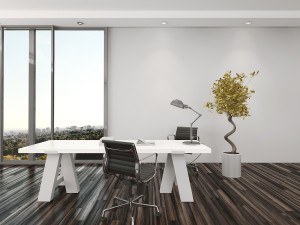Reworking the Modern Office

Not only are workers who work within the confines of the cubicle more likely to get sick from bacteria and stress, but also they are more prone to poor behavior and lower levels of productivity [see the article linked in the preceding paragraph]. So, while your boss might not be open to the idea of knocking down the cubicle walls, they should know that those very walls are impeding workers.
The Pitfalls of the Workplace
When we think of offices today, we tend to think of the newer, more open offices of the modern giants like Facebook and Google. In these wide-open spaces, it is said that we can more easily communicate with our coworkers and move more efficiently from task to task — and we’re also more likely to get a good look out those vital windows.
But research shows that the modern open-office plans is a little more than a field of wall-less cubicles. The 70 percent of Americans who work in open offices air numerous grievances with such layouts: they are far more likely to be interrupted by people and noises; they get sick often, and their productivity is hindered by a lack of privacy.
With these problems in mind, what’s the best way to arrange the workplace? Giving every single employee their own office will cost far too much money — good luck getting the boss to sign off on thatbudget. On the other hand, cubicles are as likely to make everyone hate each other as they are to increase productivity. And, to riff on a line of Winston Churchill’s, the open office may be the worst way to seat your employees, except for all the others.
Thinking Outside the Open Office
But there’s hope yet! We aren’t going to simply rattle off the downsides of office arrangements without also offering some positive inspiration. For one, consider what the the “ideal” office may look like, according to Huffington Post: plants and colors make workers happier, windows help them sleep better, ambient or natural lighting inspire more creativity, and a variety of personalized spaces make workers more productive.
Perhaps this is why giants like Facebook and Google can get away with open offices: the companies spice up their spaces in a variety of ways.
There are also other, more avant-garde ways to keep employees happy and productive. For example, Rietveld Architecture-Art Affordances (RAAAF) worked with visual artist Barbara Visser to create an “experimental work landscape” that does away with tables and chairs entirely:
“The new office is meant to help combat all of the health problems — from heart disease to diabetes — that the typical desk job can contribute to or exacerbate. Throughout the day, people lean in different positions and keep moving around the room. ‘It’s the opposite of the office chair, which evolved to be a kind of monster over time, and is forcing you to sit eight hours in the same way every day,’ [RAAAF cofounder Ronald] Rietveld says.” — Adele Peters
If you’re stuck with an open-office plan, try:
- customized headphones, to cancel the noise of your colleagues;
- a communication plan, which might include collaboration tools like Yammer, email regulations, and/or rules about interruptions;
- and staging areas for specific tasks like reading, meeting, and design.
If you have a cubicle farm you can’t change, we suggest:
- allowing employees to decorate their cubes;
- encouraging “water cooler” time via designated eating and drinking areas;
- bringing in some plant life;
- and offering stand-up desks and/or “ball chairs”.
When redesigning your office, you should keep in mind what works, what doesn’t, how we think about the way we work, and how a little bit of inspiration can a long way in making your employees happier and more productive!

